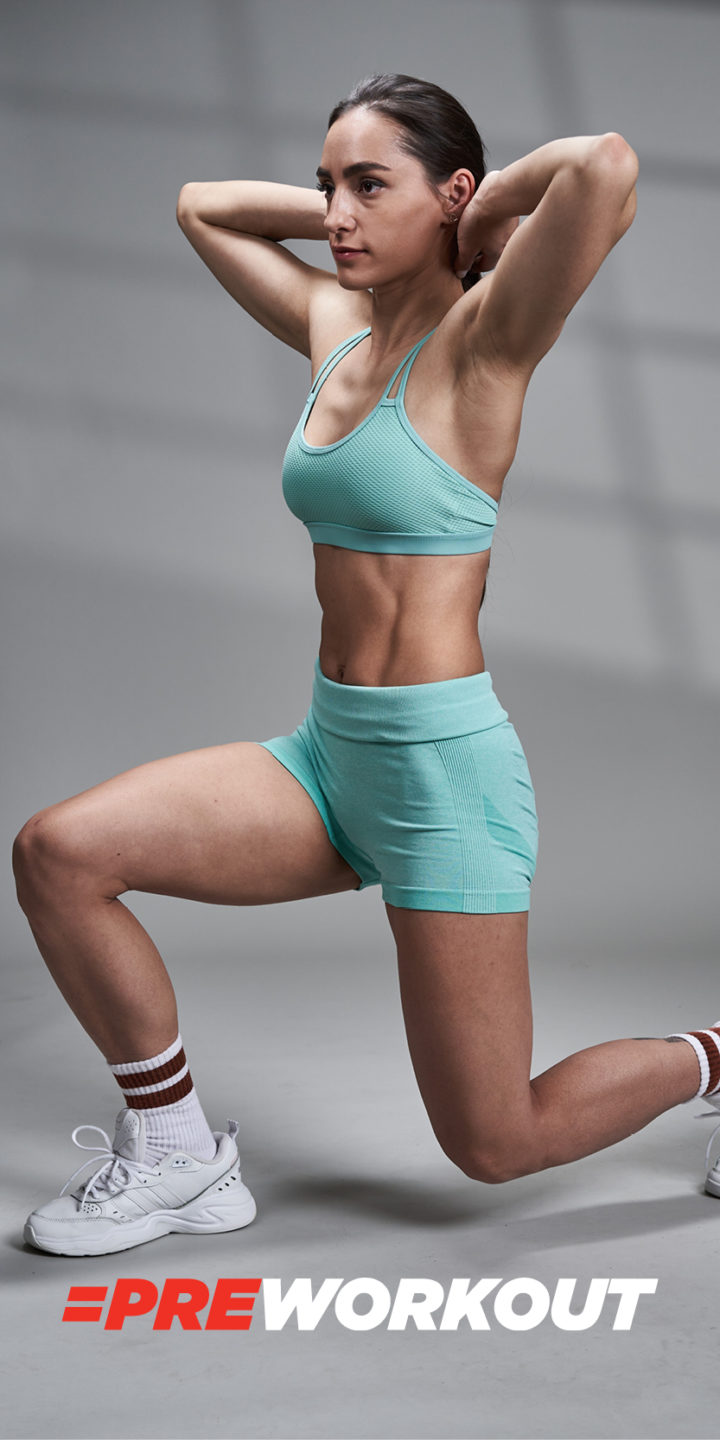Hip flexor muscles are responsible for flexing the hip to bring the knee closer to the chest and as well as helping maintain stability, postural alignment, flexibility, and mobility.
These muscles are vital for everyday movement, as they’re used each time we take a step. If your hip flexors feel “tight”, they might just need strengthening. Strengthening your hip flexors can address both weakness and tightness. Keeping the hip flexors strong will also improve your mobility and prevent injury, especially as you age.
What are Hip Flexors?
The hip flexors consist of 5 key muscles that contribute to hip flexion:
- Iliacus: Located deep in the pelvis connecting the ilium bone to the lesser trochanter of the femur (thigh bone). Iliacus is responsible for flexing and rotating the thigh.
- Psoas major: Connects the legs to the spine. It originates from the lower back and runs to the pelvis passing to the front of the hip, where it attaches to the top of the femur (thigh bone). It contracts as the hip is flexed.
- Pectineus: Extends from the pubis to the area just below the lesser trochanter of femur (thigh bone). Located in the groin area, resting at the top of the inner thigh.
- Rectus femoris: Part of the quadriceps group, which attaches the pelvis to the knee and aids in knee extension.
- Sartorius: The longest muscle spanning both the hip and knee joints. It is responsible for flexing and moving the knee and leg.
2 Main Causes of Weak Hip Flexors
- Lack of exercise
Not engaging in regular physical activity will lead to weak hip flexors. When our muscles are not challenged consistently, they will degenerate and become weak, which is known as muscle atrophy.
- Sitting for long periods
A sedentary lifestyle or being seated for extended periods as part of work can lead to a weakened psoas muscle. This is because the muscle does not work as hard as if the person were standing, walking, etc.
Symptoms of Weak Hip Flexors
The hip flexors play a major role in walking, postural alignment, joint mobility, flexibility, and balance. When the hip flexors are weak, other muscles are forced to overcompensate which can cause:
- Hip pain
Hip pain can occur when the joint is overcompensating for the weakened hip flexor.
- Back pain
The hip flexor is an important spinal stabilizer. Weakness in this area can lead to pelvic tilt, which compromises posture and can lead to lower back pain.
- Knee pain
Knee pain can occur when the joint is overcompensating for the weak hip flexor.
- Changes in walking pattern and/or trouble walking
The change in walking pattern most seen in individuals with weak hip flexors is stiff-knee gait. This is characterized by walking with a limited bend, knee flexion, in the knee.
The psoas muscle is responsible for moving the leg forward while walking. A weak psoas can make walking difficult.
Adverse Effects of Weak Hip Flexors
If you spend the majority of the day sitting down, you could have shorter hip flexor muscles. This can lead to tilting of the pelvis, which can in turn change your walking pattern.
Weakness in the hip flexors can also result in injury, as well as the symptoms listed above. An injury could occur to the spine, legs, and knees if they are forced consistently to overcompensate for weakness in the hip flexor muscles.
Reasons to Strengthen Your Hip Flexors
- Improved Lumbo-Pelvic Stability
Hip Flexor muscles attach on the pelvis, spine, and the femur and are key in providing stability to the pelvis and spine.
- Greater Control of Hip Mobility
Having mobility doesn’t necessarily mean you are able to control that mobility.
- “Tight” Feeling in the Hip Flexors Diminishes
As we mentioned before, hip flexors can feel “tight” when they are weakened.
- Less Discomfort or Pain in Lower Back and Hip Areas
Sometimes weakened areas can cause discomfort or pain. Strengthening the hip flexors could improve how these areas feel.
- Greater Performance in Sports and in Workouts
Better lumbo-pelvic stability will transfer greatly to both your lifts and athletic performance.
Exercises for Stronger Hip Flexors
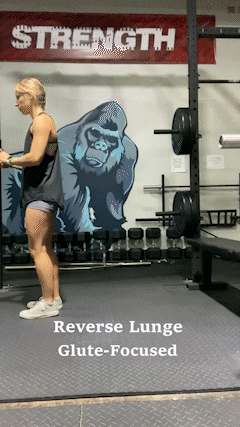
Reverse Lunge
The reverse lunge is great for hip flexor strength and mobility.
How to:
- Stand with feet shoulder-width apart, hands at side or on your hips.
- With your right foot, step back to a comfortable distance, landing with the ball of that foot on the ground and your heel up.
- Note: Think “train tracks” not “tightrope”. Don’t place one foot directly behind the other or you’ll lose balance.
- Lower the back leg straight down until your knee hovers over the floor, creating a 90-degree angle in the front leg.
- Push through the heel and midfoot of the front leg to return to standing, bringing your right foot back in line with your left. Repeat on the left side.
- Start with 8 to 10 reps on each leg, alternating sides.
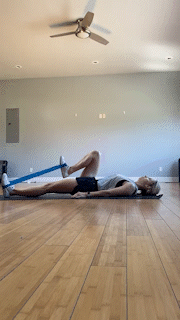
Lying Banded Psoas March
The lying banded posas march adds resistance to your hip flexor exercises.
Bands can conveniently be taken anywhere, making this an exercise you can do at home, at the gym or even in the hotel.
How to:
- Lie down with a band looped around your feet and your arms by your sides.
- Exhale as you bring your right knee towards your chest.
- Return to the starting position and alternate sides.
- Start with 8 to 10 reps on each leg, alternating sides.
Standing Banded Psoas March
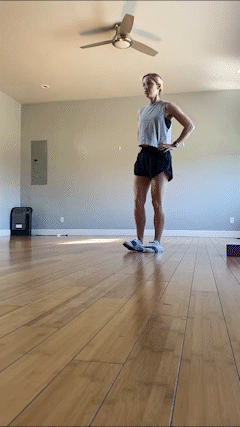
Another variation of the posas march, the standing banded posas march is done from a more natural position and involves a more natural movement.
Give it a shot the next time you are looking to strengthen your hip flexors!
How to:
- Stand hip-distance apart with arms at your sides and core engaged. You can place your hand on a wall or anything sturdy for balance.
- Loop a mini resistance band around the balls of both feet. Start with a lighter resistance and work your way up to a heavier resistance.
- Brace your core and bring your right knee up and out in front of you like you are marching. Then do the same with the left knee.
- Start with 8 to 10 reps on each leg, alternating sides.
Standing Weighted Psoas March
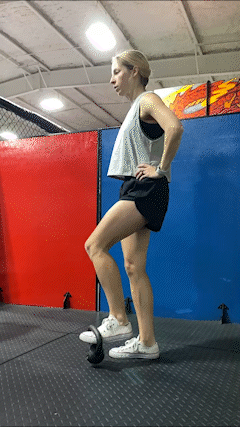
Bands are limited in the amount and granularity of resistance. If you’d like more control over the amount of resistance you have, try the standing weighted psoas march.
Another great way to strengthen your hip flexors!
How to:
This is a progression from the Standing Banded Psoas March
- Stand hip-distance apart with arms at your sides and core engaged. You can place your hand on a wall or anything sturdy for balance.
- Place your flexed right foot in the handle of a kettlebell. Start with a light-weight kettlebell and work your way up to a heavier resistance.
- Brace your core and bring your right knee up and out in front of you like you are marching. Then do the same with the left knee.
- Start with 8 to 10 reps on each leg, alternating sides.
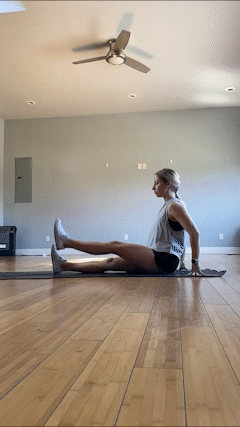
Seated Straight Leg Raise
The seated straight leg raise is another hip flexor strengthening and mobility exercise that is deceptively harder than it looks. Keeping your legs straight is key.
Try this one out next time you do a hip flexor workout routine!
How to:
- Place your hands behind you for stability while engaging your core and sitting up straight.
- While keeping the knee straight, raise one leg off of the floor and slowly back down with control.
- Repeat with the opposite leg.
- Start with 5-8 reps on each leg, alternating sides.
Seated Straight Leg Hurdles Over Blocks
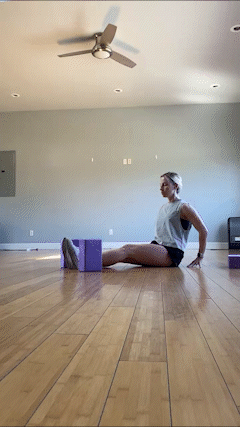
The seated straight leg hurdles over blocks allows you to work your hip flexors in multiple ranges of motion. You are moving your leg both upward and outward, or upward and inward.
This exercise is great for strengthening you hip flexors in multiple dimensions.
How to:
- Place 2 yoga blocks (or dumbbells, kettlebells, water bottles, etc.) in front of you on either sides of both of your legs.
- Place your hands behind you for stability while engaging your core and sitting up straight.
- While keeping the knee straight, raise one leg off of the floor and over the yoga block and back down to the starting position.
- Repeat with the opposite leg.
- Start with 5-8 reps on each leg, alternating sides.
About The Author:

Megan Sparacio is a certified personal trainer who writes on health and fitness. She has over five years experience writing well-researched pieces aimed at helping folks reach their fitness and lifestyle goals.
Megan is passionate about staying up-to-date with and communicating methods to help others make lasting changes in their physical fitness and behavior and mindset. In her spare time, she enjoys spending time with her family, running and lifting, and painting.
She currently lives in Tennessee and also works as an NASM Certified Personal Trainer.
